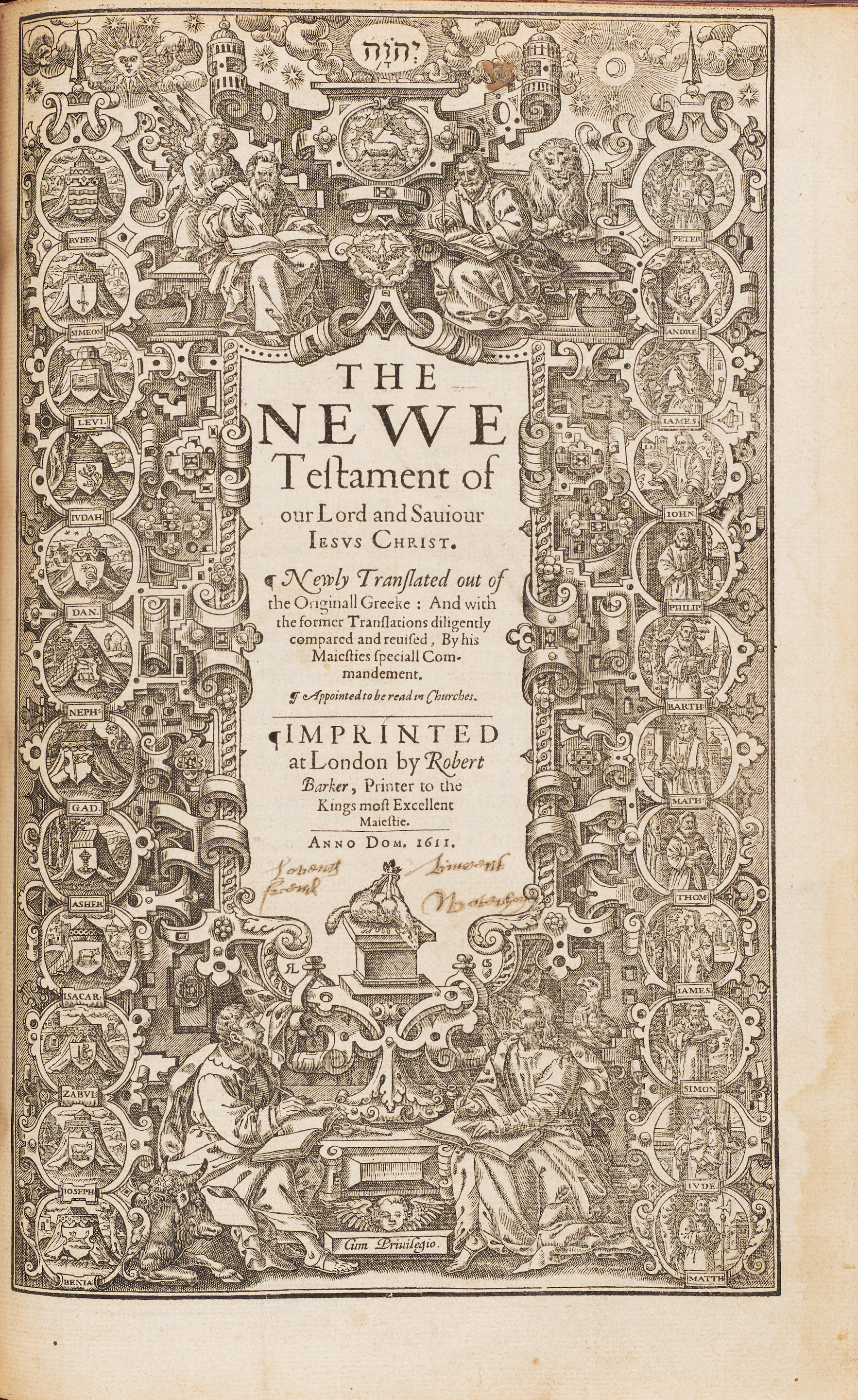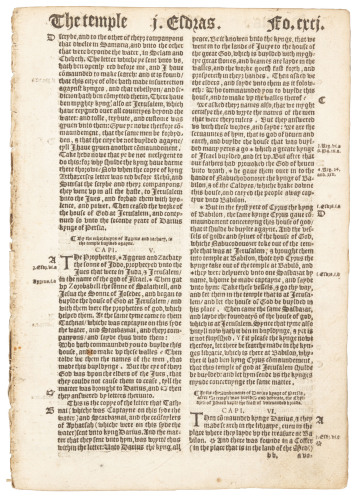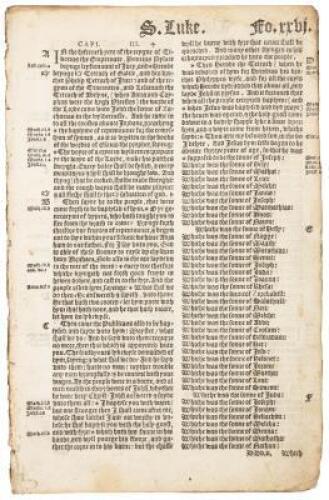BIBLE, in English, "Authorized version" -- The Holy Bible, Conteyning the Old Testament, and the New . Translated and edited by Lancelot Andrewes, Edward Lively, John Harding Miles Smith, Thomas Bilson, and about forty others. London: Robert Barker 1611[-1613]. - John SPEED The Genealogies recorded in the sacred scriptures . [London: J. Beale, 1613?]. Royal 2° (411 x 275mm). Collation: & #960;A-B 4 & #960;C 6 & #960;D 4 (A1r printed title, A1v blank, A2r dedication to King James I, A3v translators to the reader, C1r calendar printed in red and black, D1r almanac printed in red and black, D1v Easter table in red and black, D2r table and calendar, D4v books of the Bible in red and black); A-C 6 D 2 (Speed's Genealogies , and map); A-Z 6 Aa-Zz 6 Aaa-Zzz 6 Aaaa-Zzzz 6 Aaaaa-Ccccc 6 (Old Testament and Apocrypha); 2 A- 2 Z 6 2 Aa 6 (New Testament). 732 leaves. 59 lines, double columns. Black-letter type with roman for chapter summaries, and roman and italic for marginalia. Woodcut title border (McKerrow & Ferguson 231) signed RL and CS, decorated and historiated woodcut initials, two-page engraved map by Elstrack in the Genealogies. Facsimile of the 1611 "He" Bible engraved title inserted. (Very occasional foxing or light staining, map repaired at lower margin affecting text slightly and mounted on guard, πA1 with margins extended and mounted on guard, πA2-3 repairs to margin affecting outer rule only and mounted on guards, 2 Aa3,4,6 mounted on guards and margins repaired, affecting marginalia in 2 Aa6, minor repairs to a few other leaves.) Gold-tooled blue morocco, sides panelled with rolls, fillets and corner ornaments, spine tooled in compartments, gilt turn-ins, marbled endpapers, gilt edges, an early binding by Francis Bedford of the 1850s. Second folio edition of King James' Bible, also known as the "Great She Bible." King James' Bible, or the Authorized Version, set out to reconcile the versions of the Bible used by the clergy on one hand and the laity on the other. The translators, who numbered more than 40 and were divided into five committees based at Oxford, Cambridge and London, were instructed to take the Bishops' Bible as their basis and consult Tyndale's, Coverdale's, Matthew's, Whitchurch's and the Geneva versions. The result was a translation that remained unaltered for three and a half centuries in language remarkable for its power and beauty. Styled by Fry as the first edition, second issue, of King James' Bible, it is, more accurately, the second folio edition. The title-page bears the date of the first edition, 1611, but on closer inspection it appears to have been altered from 1613, as in a few other copies known. It also has changes to the type-setting which agree with the 1613 title-page. This edition is known also as the "Great She Bible" for the more correct reading "she went into the citie" in Ruth 3,15. It is characterised by the large number of leaves, about one-third of the total, which exist in two states. The present copy is almost exclusively the "B" state as outlined by W. Smith, with the only exceptions being fos. Ll2.5, Kkk2.5, Rrr3.4, which are in state C. While "Doppeldrucke" are known from the 15th century onwards, this method of economizing was particularly suited to printing Bibles. Pages in later editions by the same printer could be re-set with identical endings, thus rendering the sheets interchangeable, and copies could be made up with sheets of any edition which were available. This had already been practiced in English Bibles as early as 1539 with the appearance of the Great Bible. (See A.W. Pollard, Records of the English Bible , pp.62-67.) The Genealogies which accompany this book have a similar typographical history to that of King James' Bible itself. John Speed was granted a patent in 1610 for ten years to issue and insert his Genealogies and map in every edition of this Bible. They too are comprised of reprinted sheets in varying combinations. The present copy has the sea o
BIBLE, in English, "Authorized version" -- The Holy Bible, Conteyning the Old Testament, and the New . Translated and edited by Lancelot Andrewes, Edward Lively, John Harding Miles Smith, Thomas Bilson, and about forty others. London: Robert Barker 1611[-1613]. - John SPEED The Genealogies recorded in the sacred scriptures . [London: J. Beale, 1613?]. Royal 2° (411 x 275mm). Collation: & #960;A-B 4 & #960;C 6 & #960;D 4 (A1r printed title, A1v blank, A2r dedication to King James I, A3v translators to the reader, C1r calendar printed in red and black, D1r almanac printed in red and black, D1v Easter table in red and black, D2r table and calendar, D4v books of the Bible in red and black); A-C 6 D 2 (Speed's Genealogies , and map); A-Z 6 Aa-Zz 6 Aaa-Zzz 6 Aaaa-Zzzz 6 Aaaaa-Ccccc 6 (Old Testament and Apocrypha); 2 A- 2 Z 6 2 Aa 6 (New Testament). 732 leaves. 59 lines, double columns. Black-letter type with roman for chapter summaries, and roman and italic for marginalia. Woodcut title border (McKerrow & Ferguson 231) signed RL and CS, decorated and historiated woodcut initials, two-page engraved map by Elstrack in the Genealogies. Facsimile of the 1611 "He" Bible engraved title inserted. (Very occasional foxing or light staining, map repaired at lower margin affecting text slightly and mounted on guard, πA1 with margins extended and mounted on guard, πA2-3 repairs to margin affecting outer rule only and mounted on guards, 2 Aa3,4,6 mounted on guards and margins repaired, affecting marginalia in 2 Aa6, minor repairs to a few other leaves.) Gold-tooled blue morocco, sides panelled with rolls, fillets and corner ornaments, spine tooled in compartments, gilt turn-ins, marbled endpapers, gilt edges, an early binding by Francis Bedford of the 1850s. Second folio edition of King James' Bible, also known as the "Great She Bible." King James' Bible, or the Authorized Version, set out to reconcile the versions of the Bible used by the clergy on one hand and the laity on the other. The translators, who numbered more than 40 and were divided into five committees based at Oxford, Cambridge and London, were instructed to take the Bishops' Bible as their basis and consult Tyndale's, Coverdale's, Matthew's, Whitchurch's and the Geneva versions. The result was a translation that remained unaltered for three and a half centuries in language remarkable for its power and beauty. Styled by Fry as the first edition, second issue, of King James' Bible, it is, more accurately, the second folio edition. The title-page bears the date of the first edition, 1611, but on closer inspection it appears to have been altered from 1613, as in a few other copies known. It also has changes to the type-setting which agree with the 1613 title-page. This edition is known also as the "Great She Bible" for the more correct reading "she went into the citie" in Ruth 3,15. It is characterised by the large number of leaves, about one-third of the total, which exist in two states. The present copy is almost exclusively the "B" state as outlined by W. Smith, with the only exceptions being fos. Ll2.5, Kkk2.5, Rrr3.4, which are in state C. While "Doppeldrucke" are known from the 15th century onwards, this method of economizing was particularly suited to printing Bibles. Pages in later editions by the same printer could be re-set with identical endings, thus rendering the sheets interchangeable, and copies could be made up with sheets of any edition which were available. This had already been practiced in English Bibles as early as 1539 with the appearance of the Great Bible. (See A.W. Pollard, Records of the English Bible , pp.62-67.) The Genealogies which accompany this book have a similar typographical history to that of King James' Bible itself. John Speed was granted a patent in 1610 for ten years to issue and insert his Genealogies and map in every edition of this Bible. They too are comprised of reprinted sheets in varying combinations. The present copy has the sea o

.jpg)



.jpg)








Testen Sie LotSearch und seine Premium-Features 7 Tage - ohne Kosten!
Lassen Sie sich automatisch über neue Objekte in kommenden Auktionen benachrichtigen.
Suchauftrag anlegen